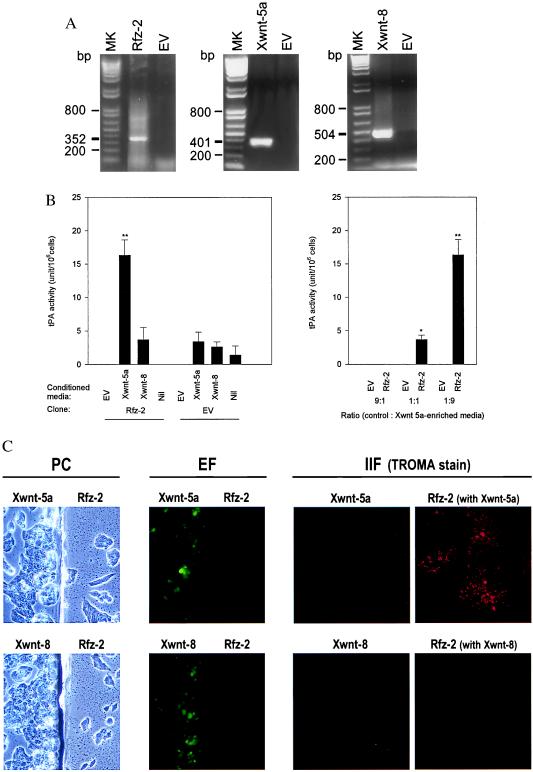Figure 1.
Conditioned medium from cells expressing Xwnt-5a, but not Xwnt-8, stimulates differentiation of mouse F9 teratocarcinoma cells expressing Rfz-2 to PE, as established by the expression of the PE marker, tPA. (A) F9 clones stably transfected with the vector expressing Rfz-2 receptor, Xwnt-5a, Xwnt-8, or empty vector (EV) were selected on the basis of expression of target mRNA, as measured by reverse transcription–PCR. The molecular markers (MK) indicate relative size in bp of the amplified product. Boldface tick marks identify expected product. (B) Conditioned medium was collected from F9 clones stably transfected with Xwnt-5a, Xwnt-8, or the empty vector and used to supplement 1:9 (ratio of conditioned medium of target Rfz-2-expressing clones to that of the Wnt-expressing clones) the medium of the F9 cells stably expressing either Rfz-2 or the empty vector (EV; Left). Nil denotes the clones to which no conditioned medium was added. The ratio of conditioned medium of the target Rfz-2-expressing clones to that of the Wnt-expressing clones was varied from 9:1 to 1:9, and the PE formation was followed by tPA activity (Right). The tPA activity is calculated as described (47). The results are presented as the mean values ± SEM of at least four separate experiments. *, P < 0.05 for difference from the mean. (C) Coculture of Rfz-2 receptor-expressing F9 clones with clones expressing green fluorescent protein (GFP) and either Xwnt-5a or Xwnt-8. Coverslips on which Rfz-2-expressing cells had been cultured were transferred to Petri dishes seeded with clones expressing a single Wnt ligand (phase contrast, PC). Epifluorescence (EF) analysis reveals the GFP/Wnt-producing clones; the Rfz-2-bearing clones are negative. Indirect immunofluorescence (IIF) analysis of coculture partners reveals positive TROMA staining (indicative of PE formation) only for cocultures of Rfz-2 cells with Xwnt-5a- but not Xwnt-8-producing clones.

